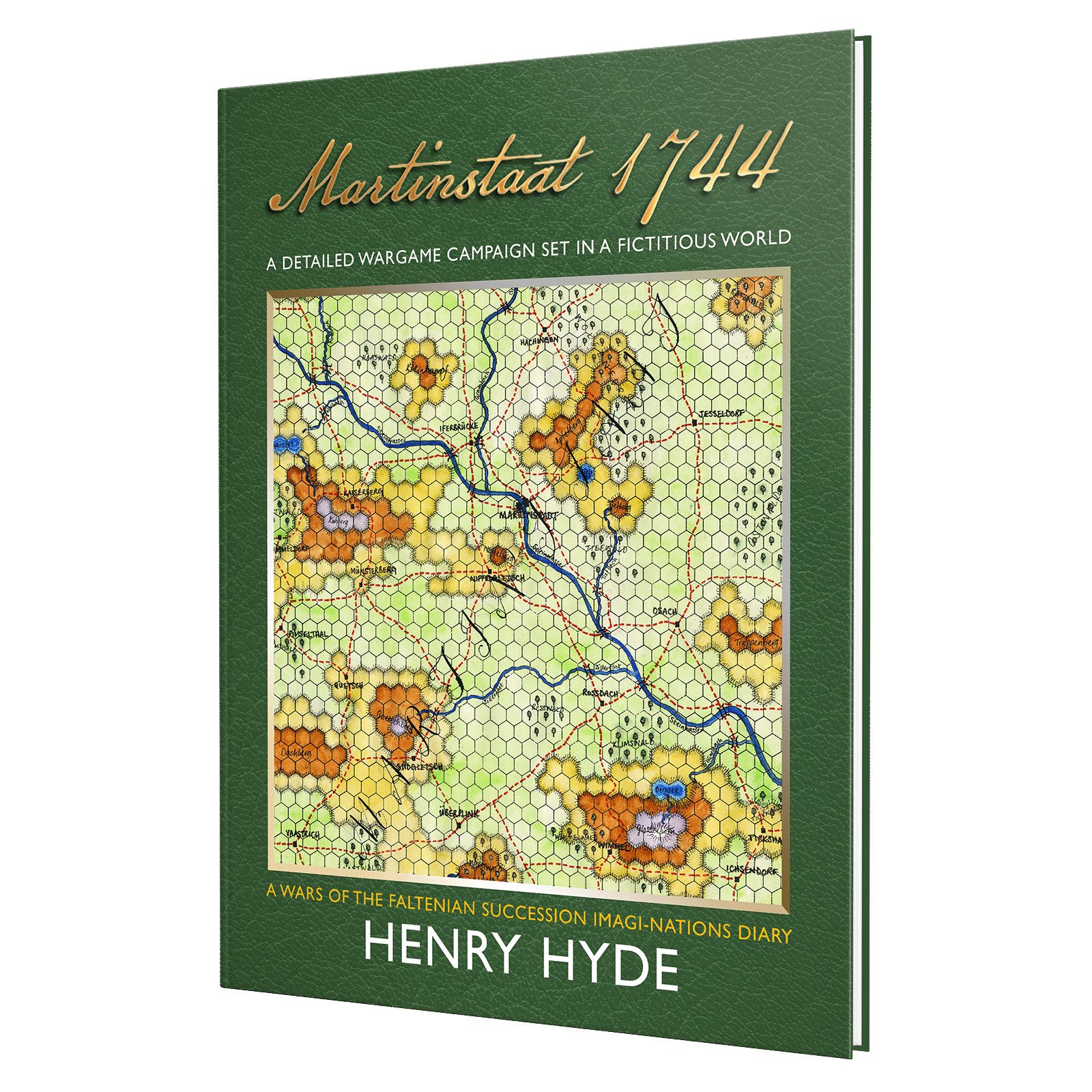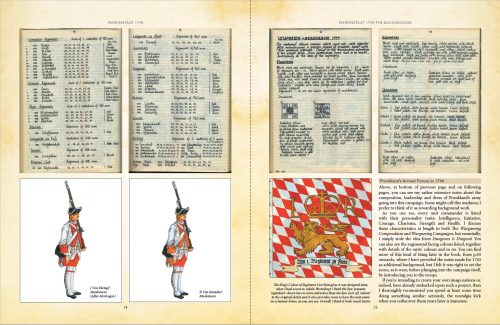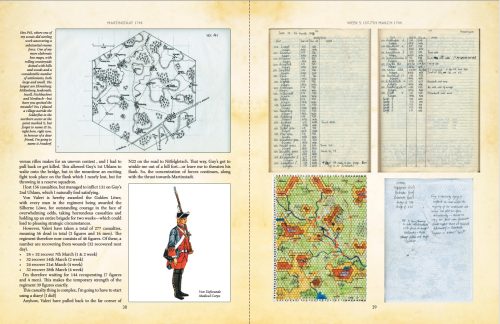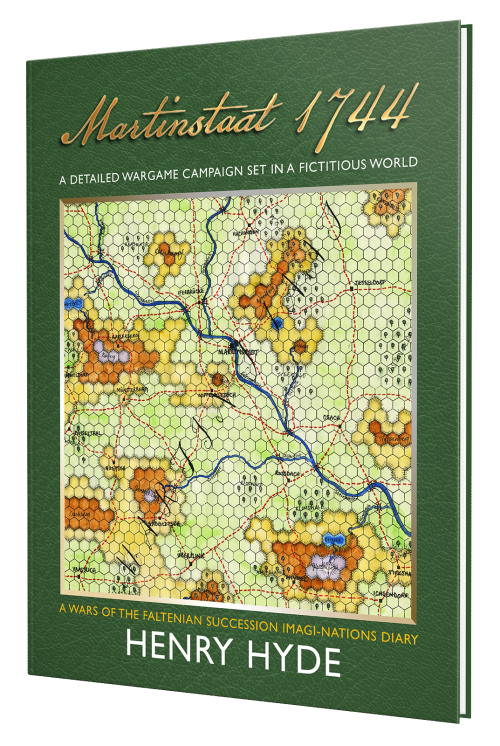
NB The Payhip site has been renamed and is now at https://payhip.com/gladiuspublications
After a couple of frantic months of activity, my latest book Martinstaat 1744, A Detailed Wargame Campaign Set in a Fictitious World, is finally available in PDF, paperback and hardback formats.
Some of you may not even be aware of how this project came about.
A few months ago, I posted some images on Twitter (as it was then called, now simply ‘X’ of course) of a few pages from my campaign diaries. To me, they were just the weekly records I had kept of my Wars of the Faltenian Succession campaigns that I had fought with my chum Guy Hancock back in the late 1980s and early 1990s.
But people seeing the tweets were wowed by the fact that everything was handwritten and very neat and tidy! I suppose we all take our own handwriting for granted, and the sad fact seems to be that it’s a dying art nowadays. I have also been interested in calligraphy since my late teens, and I confess that one of my extremely nerdy pursuits has been (though not for many years) to write out page after page of alphabets in different historical script styles in order to achieve a level of competence that I now concede is considered unusual. (For those interested, it’s also a fantastic form of mindfulness, almost meditation.)

Moreover, alongside my notes in the campaign diaries, I had made little diagrams, drawings and maps. Obviously, anyone who has read either The Wargaming Compendium or, more especially, Wargaming Campaigns will also know that I’m a bit of a cartography nut, and the fact is that I had amassed quite a lot of maps from my time gaming with Guy, both large-scale landmass maps and the smaller, ‘zoomed in’ 5-mile hexagons containing a great deal of detail at those points where our armies made contact.
One follower in particular, known online as @WargameCulture (Purple Druid on YouTube), was particularly vociferous in his suggestions that I really ought to publish this stuff as a proper book. I was rather taken aback at the suggestion initially, but others chimed in too, so after a great deal of thought I returned to my campaign diaries and started thinking about how best to approach such a venture.
I have kept a LOT of stuff from my campaigns. Some of it is very tidily stowed in folders, ring-binders and large, A4 notebooks, whilst other bits and pieces were floating around here in the Loftwaffe in the form of scraps of paper stuffed into boxes and cupboards. Eventually, I was able to sift through it all and conclude that the most complete records I have from the pre-internet era dealt with the 1744 campaign, played with Guy during the 1990-91 period.
It was at this time that my ‘real’ life was actually undergoing a lot of upheaval, because I’d bought a flat in Essex at a time when interest rates were going quite literally through the roof and just before everyone plunged into ‘negative equity’; I’d just met a new girlfriend (Annie, who is still my partner 32 years later); and I quit my life insurance job and moved down to Brighton & Hove where I started a new career in graphic design! Quite how I managed to keep a wargame campaign going at a time like that is beyond me—I can only think that I found it comparatively therapeutic!
Anyway, the 1744 campaign proved to be fertile ground for a book project, though organising all the notes took some doing, and I had to sit down and do a great many scans of the diary pages: I think the final tally was something close to 100 scans of my handwritten text, along with some others of typewritten notes. I also scanned in the week-by-week campaign move maps, but decided that they were of too poor quality to reproduce, since they were originally just black and white photocopies with scrawled notes on them. As a result, I used the original hand-coloured map of Martinstaat (created at A3 size, 297 x 420mm) which I scanned in, before adding layered overlays in Photoshop on which I indicated the positions of the units as described in the accompanying notes. This gives a nice move-by-move picture of the manoeuvres of both sides. Sadly, Guy’s notes were nowhere near as detailed as mine, but I had kept all the co-ordinates that he supplied to me in his weekly letters, and my own notes about whether either of us had decided to advance, retreat, evade or fight when contacts were made.

Having assembled the core information, I was able to set about transcribing my own week-by-week notes about what was happening (again, this was at the request of fans) and embarked on the layout. It was as this was going on that I realised three things: first of all, I needed to explain why there were no photos of games from this (pre-internet, pre-digital photography) campaign; therefore, secondly, I needed to find other, appropriate images of imagi-nations games in progress that would help to create that imagi-nations feel; and finally, I needed to create some illustrations to show readers what our armies looked like.
Fortunately, I unearthed a few watercolours that I had painted way back in the late 1980s and early 1990s that were, in fact, contemporary with the campaign. But I also set about creating 31 brand new watercolours showing the uniforms of Prunkland’s expeditionary force. At times, as only a very occasional illustrator, I felt like I had bitten off far more than I could chew, but I just kept doggedly sitting at my table with brush in hand and, rather like when we are painting miniatures, eventually I realised it was done. Phew!
Then it was a matter of assembling all the elements, writing a few extra pieces to help the whole thing make sense to the reader, and finally doing all those boring behind-the scenes technical checks and proofreading run-throughs that help make the difference between a self-published book that looks like it, and something that is a professionally-produced volume that not just meets, but hopefully exceeds the standards achieved by many ‘traditional’ publishers. (My profound thanks to Paul Caspall for his brilliant last-minute help on the proofreading front.) I make no apology for setting myself exacting standards and doing my best to show that self-publishing no longer equates with vanity publishing or shoddiness.
So then it was upload time, to the Payhip site, to Wargame Vault and, of course, to Amazon, from whom I ordered proof copies to ensure that everything was OK, And just as well I did, because I discovered a technical error as a result, which I was able to correct before hitting the “Publish” button. (For the nerds among you, I had not allowed sufficient bleed around the page for the background parchment effect.)
After that, well, still no time to relax, because what’s the point in publishing a book if you don’t tell the world? So, back onto Twitter/X and Facebook and Instagram and Threads and Patreon to announce its birth to the world, and pray that all this hard work results in decent sales, or I’ve just wasted a couple of months of my time! 😄
As I write this, it looks like it has been worth it, because the book just entered the top 10 on Amazon’s Role-Playing & Wargames category at number 9. Woohoo!
So, thank you to everyone for your support, for your encouragement and, in a few specific cases, your direct inspiration! Social media gets a bad rap most of the time, but just occasionally, some real magic can emerge from engagement with other enthusiasts online, and this book is just one example of that. I hope you like it! Meanwhile, I’ll be starting work on the Next Big Thing…

P.S. If you buy a hard copy of the book, you also get access to an extra PDF book of all the week-by-week maps at a larger size—and at whatever price you decide!
As an Amazon Associate I earn a small amount of commission from qualifying purchases.

The book is great! And I want to read the rest of the story in its entirety. I mean, what happened after a little fight in the book “Rules in Action”. But in Martinstaat, I was more interested in the pages devoted to army spending and everything related to it. In this regard, questions immediately arose…
If we take the maintenance costs based only on the data in the price list and the motives for spending our money, it turns out that the state receives income from the hexes, which is incomparable with the cost of maintaining the units. I mean, either you can hire a lot of people, or there’s a lot of money left in the treasury. I have a suspicion that not all the details of this, in my opinion, fascinating process were described in the appendix dedicated to army expenses. The fact is that besides my fascination with the 18th century, I also have my own medieval kingdom… Sometime in the early 1980s (golden barefoot childhood) I had my own kingdom of Byzantine-style toy soldiers… Which I did not give up later. And in the early 2010s, I got acquainted with Bath’s book about creating my campaign and transferred my fantasy Byzantium to the rails of the Bath economy 🙂 In your interpretation of the 18th century, this system is a bit simpler.
Of course, the cost of maintaining the regiments also included the cost of shooting, field trips, something else? Am I wrong? Because if you take, for example, the cost of a cavalry regiment, then if you do not add the cost of training, something else, shooting practice for dragoons, for example, then a cavalry regiment will not turn out to be such an expensive enterprise… As for me, I have come to a certain system ((an infantry battalion of 6 companies costs me 7,300 a year, a grenadier company – 2,100, and so on), but it would still be very interesting to know how much, with an income in Prunkland, you spend per year on the maintenance of various units. And more… Have there been (and are there if life in your world is still boiling) events unrelated to wars and campaigns? Have you dealt with this using only your event cards? Or was there something else? And were there any expenses for non-military activities? And you won only with your event cards? Or was there something else? Faction fighting? Two generals who hate each other end up obeying each other? Officer dynasties? A marriage between the children of generals who hate each other? Something that is not directly related to the campaign, but breathes life into it? For example, to calculate non-military expenses, I take calculations from the Glory of Kings rule system – you probably know it…
The hardback arrived at the weekend and it’s superb! A very inspiring piece of work. I’d already begun my own made-up toy soldier land in 10mm, but think I’ll swap to something more old fashioned and shiny (possibly 15mm SYW Essex figures) after reading this. Wonderful stuff. Incidentally, I tried to download the PDF of the Steel, Shot and Stone player aid, but the link takes me to some additional army lists instead. Any chance you could give that a look please? Thanks!
Thank you for your very kind comments Barry. Good luck with your own endeavours and I’ll certainly check that link later today.
I received my hardback copy this morning and quickly dipped into it. What a beautiful piece of work. The layout and illustrations are wonderful. I would ask will you be putting the information that you presented about Prunkland in a similar format for Faltenland in a future publication? Well done Henry. Fabulous!
Thank you for your very kind comments! As you’ll read in the book, I can’t do the same for Faltenland for the time being because Guy didn’t keep anything like the same level of notes! However, one day I shall ‘level up’ the record keeping for Queen Ingrid’s forces.
Look Excellent!!
Im busy re-painting my Spencer-Smith plastics AWI figures. Apart from Airfix 1/72nd. WWII Brits were my first attempt at painting.
Then I have some old Tony Barton SYW to paint then Eureka Prussians Austrians and Prussians also a Brit. Army from Eureka.
Then I have to decide on the scale to use for imaginations 28mm or 18mm.
If I’m upto clearing out my garage 20ft. X 20ft.
Or continue in a bedroom with a
6’ x 4’ table as I now play solo probably the latter is the most sensible.
But then I’m a Wargamer
Thanks Mike and it sounds like you’re keeping busy!
At 79 I’ve given up chasing women☹️
But I have to keep wargaming and a 2 to 3 hour engagement is a good target for a Friday night game
WWII Too Fat Lardies are my favourites.
Sharp Prractice is a good fun game but I want a Division Level game that suit what I’m looking for and Trevor Halsall’s Napoleonic Warfare fit the bill for a game but making any game solo that works well.
Set up on table requires blinds for both sides 6 blinds require 6 forces plus a blank blind place the cards in position where you hope your army will be
Turn the cards over and lowest card is force 1, the highest card being the empty blank.
Put the figures in place as a solo game both sides are in a mess but not equal.
The forces would be 1 battalion of infantry or one of 2 regiments of cavalry artillery is with 1 of the force lists as are light infantry detachment.
If it wet or windy this weekend I’ll play a game to see if it works (unlikely) but at least I get to play an accidental contact game.